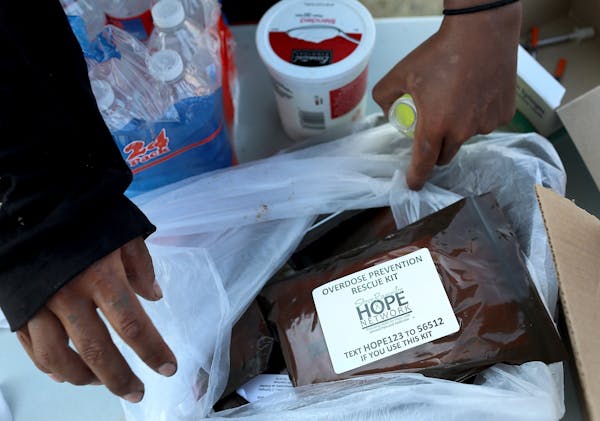Minneapolis has seen a dramatic spike in drug overdoses, with police officers responding to at least 50 cases over a seven-day period — a new all-time high for a single week, authorities say.
The previous weekly high of 39 was recorded last year.
Police say the overdoses occurred during the week of May 28-June 3, with nearly half of the cases in the Third Precinct, which covers neighborhoods south of downtown and in the city's southwestern segment. The East Phillips neighborhood, in particular, was hit hard, police say.
At least 15 of the overdoses occurred on Sunday alone, including one resulting in death. In that case, Park Police responded to an overdose at a park near the Minneapolis Institute of Art, where they found a 27-year-old man with syringes, a metal cap with drug residue and some medication that wasn't in his name.
"It is nearly impossible to attribute the entirety of this spike to just one source, and all illicit drugs bought on the street should be considered dangerous and have the potential to contain powerful opiates such as fentanyl or carfentanil," the department said in a news release.
While state authorities have expressed concern about a resurgence of meth, the recent string of overdoses in Minneapolis is suspected to be linked to opioids — including "counterfeit Oxycontin, potent heroin and additional unknown substances," according to police spokesman John Elder.
"We are surmising that that, in fact, was the case," he said, adding that additional testing was needed.
Another 15 overdoses were logged on Tuesday and Wednesday, bringing the nine-day total to 65, he said.
So far this year, department records show that police have responded to 624 overdose-related calls — 31 were fatalities.
The numbers reinforced a worrisome trend, which city officials earlier this year said put the city on pace to easily top last year's tally of 954 calls.
Already this week, law enforcement officials in St. Paul and Washington County raised alarms after a series of overdoses from a deadly batch of narcotics.
St. Paul police issued an alert Wednesday, saying that five people overdosed from opioids in a 36-hour span. Meanwhile, the Washington County Sheriff's Office said that four people died of suspected overdoses in the past two weeks, including two deaths this week alone.
While the opioid epidemic sweeping through the Rust Belt and Appalachia has largely spared Minneapolis, parts of the city have been hit hard by heroin and prescription drug abuse.
In recent months, authorities have begun aggressively investigating fatal drug overdoses, with larger police departments like Minneapolis assigning detectives to interview witnesses and gather evidence as they would any other unnatural death, helping prosecutors build cases against drug dealers who sell to people who die.
Officers have also started carrying the opioid antidote naloxone, which they have administered 57 times so far this year.
Elder, the department spokesman, said police have taken a data-driven approach to combating the drugs and street crime around them. Last year, the department launched an internal dashboard showing how many overdose cases there have been, and where.
"We're trying to find out different ways that we can hopefully nip this in the bud, and draw these numbers, and data is absolutely one of the strong ways to do that," he said.
But Minneapolis City Council Member Alondra Cano, the public safety chairwoman, said that while she recognizes that police officers have sometimes been the first responders to such calls, she opposes taking a law-enforcement approach to what she said is a public health problem.
"We're talking about chemical dependency, drug addiction, a lot of times affected by trauma and a lack of resources," said Cano, whose ward includes some of the areas most affected by the overdoses.
She said she hoped the news would serve as a wake-up call for officials reckoning with the fallout from the closure of the Navigation Center, which shut down this week. The center opened last fall to house residents from the hundreds of tents that sprang up along Franklin and Hiawatha avenues.
"We should've had a big response plan to kind of fill that vacuum that we had in the community," she said. "When it's so concentrated in one neighborhood, it's easier for people to say, 'Well, that's not our problem.' "
In April, Minneapolis and Hennepin County officials released a set of recommendations for tackling the opioid epidemic in the Twin Cities.
Thursday's announcement coincided with a visit by U.S. drug czar James Carroll, who happened to be in Minneapolis to discuss narcotic enforcement and treatment with Minnesota police and prosecutors. Carroll praised the increased use of naloxone for potentially saving the lives of many who overdosed.
Staff writer Brandon Stahl contributed to this report.
Libor Jany • 612-673-4064
Spring's hot gift book features gorgeous found-nature photos
Victim in north Minneapolis shooting identified as man from Chicago

This St. Paul native now goes by Kandi Krush, and she body-slams her opponents in the ring

Baseball Metro Player of the Year packs up his five tools and leaves

